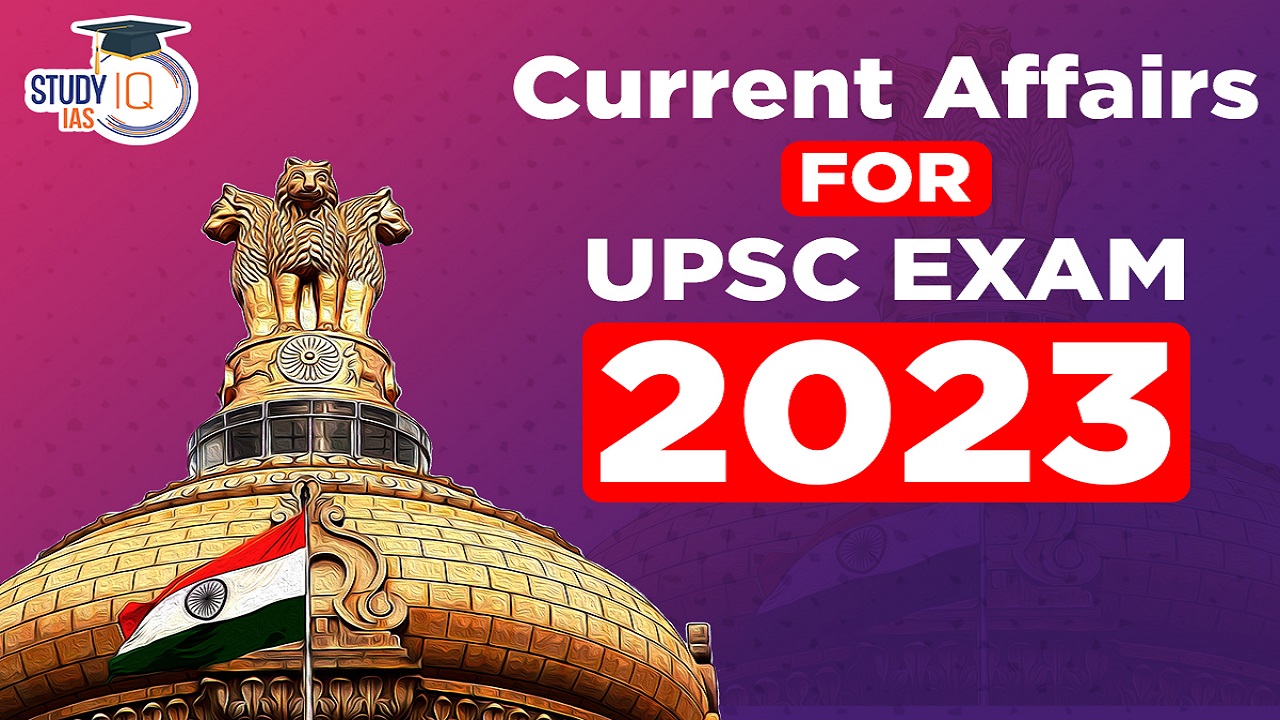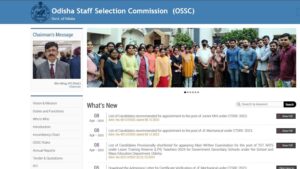Current Affairs 31st August 2023 for UPSC Prelims Exam
National Human Rights Commission (NHRC)
Context: National Human Rights Commission (NHRC) has issued notice to the Uttar Pradesh government over a video of a student.
About National Human Rights Commission (NHRC)
- Definition: The National Human Rights Commission (NHRC) of India is a statutory body.
- It was established on 12 October 1993.
- The statute under which it is established is the Protection of Human Rights Act (PHRA), 1993.
- It is in conformity with the Paris Principles, adopted at the first international workshop on national institutions for the protection of human rights held in Paris in 1991.
- Function: The commission is the watchdog of human rights in the country.
- It works to protect the right to life, liberty, equality and dignity of the individual guaranteed by the Constitution or embodied in the international covenants and enforceable by courts in India.
- The purpose of the NHRC is, suo moto or through the petition of a person, to investigate the violation of human rights or the failures of the state or other to prevent a human rights violation.
- The Commission does not have the power of prosecution. It can merely make recommendations to the government or recommend to the courts to initiate proceedings based on the inquiry that it conducts.
- Composition: The Commission consists of a chairperson, five full-time Members and seven deemed Members.
- A Chairperson should be retired Chief Justice of India or a Judge of the Supreme Court.
- Appointment: The Chairperson and members of the NHRC are appointed by the President of India, on the recommendation of a committee consisting of:
- The Prime Minister (Chairperson)
- The Home Minister
- The Leader of the Opposition in the Lok Sabha (Lower House)
- The Leader of the Opposition in the Rajya Sabha (Upper House)
- The Speaker of the Lok Sabha (Lower House)
- The Deputy Chairman of the Rajya Sabha (Upper House)
Self-Respect Marriage
Context: The Supreme Court has recently observed that there is no blanket ban on advocates solemnising “self-respect” marriages under Section 7(A) of the Hindu Marriage Act, 1955.
What are ‘Self-Respect’ Marriages?
- Background: On January 17, 1968, the Hindu Marriage (Tamil Nadu Amendment) Act, 1967, received the President’s approval and became the law.
- This amendment modified the Hindu Marriage Act of 1955, by inserting Section 7-A into it. However, it extended only to the state of Tamil Nadu.
- Section – 7A: Section 7-A deals with the special provision on “self-respect and secular marriages”.
- It legally recognises “any marriage between any two Hindus”, which can be referred to as “suyamariyathai” or “seerthiruththa marriage” or by any other name.
- Self-Respect Marriages:
- Such marriages are solemnised in the presence of relatives, friends, or other persons, with parties declaring each other to be husband or wife, in a language understood by them.
- Further, each party to the marriage garlands the other or puts a ring on the other’s finger or ties a “thali” or mangal sutra.
- However, such marriages are also required to be registered as per the law.
- Rationale Amending the Hindu Marriage Act, 1955:
- It aimed to include “suyamariyathai” or “self-respect” marriages, was to radically simplify weddings by shunning the need for mandatory Brahmin priests, holy fire and saptapadi (seven steps).
- This allowed marriages to be declared in the presence of the couple’s friends or family or any other persons.
- In a nutshell, the amendment was made to do away with the need for priests and rituals, which were otherwise required to complete wedding ceremonies.
- Recent Supreme Court’s Order:
- In its recent order, the Supreme Court allowed a petition challenging a Madras High Court order dated May 5 where the court had ordered the initiation of disciplinary action against the advocates who solemnised such marriages in their offices and issued marriage certificates to consenting adults.
- The top court relied on its 2001 ruling in “Nagalingam v. Sivagami”, which said that there is no blanket ban on advocates to solemnise marriages under Section 7(A) of the Hindu Marriage Act (Tamil Nadu State Amendment Act).
- In the 2001 judgement, the SC clarified that the parties in the case did not consider the “saptapadi” ceremony to be as essential as per their personal law, so Section 7-A of the Hindu Marriage Act (Tamil Nadu State Amendment) would apply instead.
- As per the court, the main thrust of this provision is that the presence of a priest is not necessary for the performance of a valid marriage.
- Parties can enter into a marriage in the presence of relatives or friends or other persons.
Sickle Cell Anaemia
Context: Union Minister of Tribal Affairs has recently launched the ‘Awareness Campaign and Training of Trainers’ as a part of the ‘Mission for Elimination of Sickle Cell Anaemia’ in New Delhi.
What is Sickle Cell Disease (SCD)?
- Definition: Sickle cell disease is a group of inherited red blood cell disorders that affect hemoglobin, the protein that carries oxygen through the body.
- Normally, red blood cells are disc-shaped and flexible enough to move easily through the blood vessels.
- In the sickle cell disease, the red blood cells are crescent- or “sickle”-shaped. These cells do not bend or move easily and can block blood flow to the rest of the body.

- Types: Sickle cell disease exists in two forms within the human body.
- One is the Sickle Cell trait, in which the individual does not exhibit any disease or symptoms and lives a normal life.
- The second form is characterised by the presence of symptoms related to sickle cell disease.
- Symptoms: Swelling of hands and feet, Anemia, Periodic episodes of extreme pain, infections, vision problems, significant reduction in life expectancy.
- Spread: If two individuals with Sickle Cell trait marry each other, there is a high probability that their child will have Sickle Cell disease.
- Cure: SCD can only be cured by bone marrow or stem cell transplantation.
- These transplants are normally reserved for children with severe SCD since they are hazardous and can have substantial adverse effects.
Sickle Cell Disease in India
- Affected Population: In India, there are approximately 706 different tribal communities, which constitute 8.6% of the total population. Sickle cell disease is a serious health challenge in India’s tribal population.
- Prevalence of SCD in States:
- High Prevalence: Rajasthan, Gujarat, Madhya Pradesh, Chhattisgarh, Jharkhand, West Bengal, Odisha, Telangana, Andhra Pradesh, Tamil Nadu, Kerala, Karnataka, and Maharashtra.
- Partial Prevalence: Bihar, Assam, Uttarakhand, and Uttar Pradesh.
- Prevention Approach by GoI: The first approach focuses on prevention, ensuring that new cases are not born, while the second approach involves managing the treatment and providing adequate healthcare facilities for individuals already affected by the disease.
- National Sickle Cell Anaemia Elimination Mission:
- Aim: The Mission aims to address the pressing health challenges posed by sickle cell disease, particularly among the tribal population.
- It shall eliminate sickle cell disease as a public health problem by 2047.
- The program is executed in a mission mode as part of the National Health Mission (NHM).
- Objectives:
- Provision of affordable and accessible care to all SCD patients.
- To ensure quality of care for SCD patients.
- To reduce the prevalence of SCD.
- Aim: The Mission aims to address the pressing health challenges posed by sickle cell disease, particularly among the tribal population.
Laser-Induced Breakdown Spectroscopy (LIBS)
Context: The Indian Space Research Organisation (ISRO) has said the Pragyan rover’s Laser-Induced Breakdown Spectroscope confirmed the presence of sulphur in the lunar surface near the south pole, through the first-ever in-situ measurements.

What is Laser-Induced Breakdown Spectroscopy (LIBS)?
- Definition: Laser-Induced Breakdown Spectroscopy (LIBS) is a rapid, portable, in situ atomic spectroscopy technique.
- Use: It is used to measure the concentration of major and trace elements in solid, liquid, or air samples, or to record the chemical signature (fingerprint) of a material.
- Each LIBS spectrum contains not only information about the concentrations of all naturally occurring elements, but also some isotopic ratios and information about the atomic structure of the material.
- LIBS is a spot analysis technique, with laser ablation craters on the order of 30 – 400 µm diameter, depending on the laser wavelength, power, properties of the material itself, and how well the laser couples to the material.
- Because LIBS is a spot analysis technique, it is possible to evaluate spatial changes in material composition and to average shots taken from many different locations on the materials to obtain a bulk composition.
- Process: The LIBS analyses the composition of materials by exposing them to intense laser pulses.
- A high-energy laser pulse is focused onto the surface of a material, such as a rock or soil, and generates an extremely hot and localised plasma.
- The collected plasma light is spectrally resolved and detected by charge coupled devices.
- Since each element emits a characteristic set of wavelengths of light when in a plasma state, the elemental composition of the material can be determined in this way.


 Daily Quiz 18 April 2025
Daily Quiz 18 April 2025
 OSSC CGL Syllabus 2025 and Exam Pattern ...
OSSC CGL Syllabus 2025 and Exam Pattern ...
 AI and its Regulation in India, Limitati...
AI and its Regulation in India, Limitati...





















